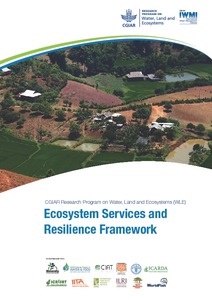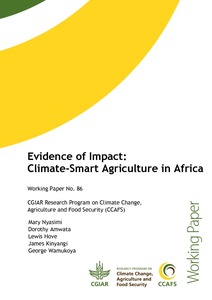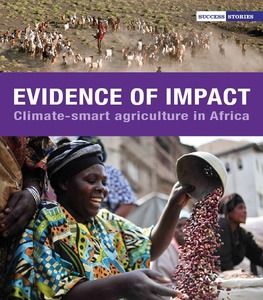Ecosystem services and resilience framework
Evidence of Impact: Climate-Smart Agriculture in Africa
The vulnerability of Africa’s agriculture to climate change is complex. It is shaped by biophysical, economic, socio-cultural, geographical, ecological, institutional, technological and governance processes that interact in intricate ways, and can together reduce farmers’ adaptive capacity. Women farmers with few resources are particularly vulnerable. This working paper highlights the array of adaptation strategies that exist across Africa’s diverse farming systems and climatic conditions. These strategies can provide the impetus for transforming Africa’s agriculture.
Evidence of impact: Climate-smart agriculture in Africa
Agriculture across Africa must undergo a significant transformation to meet the multiple challenges of climate change, food insecurity, malnutrition, poverty and environmental degradation. The case studies described here are just some of the climate-smart agricultural practices that already exist in Africa. This publication aims to inspire farmers, researchers, business leaders, policy makers and
NGOs to take up the mantle of climate-smart agriculture and accelerate the transformation of Africa’s agriculture into a more sustainable and profitable sector.
Identifying determinants, pressures and trade-offs of crop residue use in mixed smallholder farms in Sub-Saharan Africa and South Asia
Crop residues (CR) have become a limited resource in mixed crop-livestock farms. As a result of the increasing demand and low availability of alternative resources, CR became an essential resource for household activities, especially for livestock keeping; a major livelihood element of smallholder farmers in the developing world. Farmers’ decisions on CR use are determined by farmers’ preferences, total crop production, availability of alternative resources and demand for CR. Interaction of these determinants can result in pressures and trade-offs of CR use.
Implementing REDD+ (Reducing Emissions from Deforestation and Degradation): evidence on governance, evaluation and impacts from the REDD-ALERT project
The REDD-ALERT (Reducing Emissions from Deforestation and Degradation from Alternative Land Uses in the Rainforests of the Tropics) project started in 2009 and finished in 2012, and had the aim of evaluating mechanisms that translate international-level agreements into instruments that would help change the behaviour of land users while minimising adverse repercussions on their livelihoods. Findings showed that some developing tropical countries have recently been through a forest transition, thus shifting from declining to expanding forests at a national scale.
Land-use change trajectories up to 2050: insights from a global agro-economic model comparison
Changes in agricultural land use have important implications for environmental services. Previous studies of agricultural land-use futures have been published indicating large uncertainty due to different model assumptions and methodologies. In this article we present a first comprehensive comparison of global agro-economic models that have harmonized drivers of population, GDP, and biophysical yields. The comparison allows us to ask two research questions: (1) How much cropland will be used under different socioeconomic and climate change scenarios?
Managing Potato Biodiversity to Cope with Frost Risk in the High Andes: A Modeling Perspective
Austral summer frosts in the Andean highlands are ubiquitous throughout the crop cycle, causing yield losses. In spite of the existing warming trend, climate change models forecast high variability, including freezing temperatures. As the potato center of origin, the region has a rich biodiversity which includes a set of frost resistant genotypes. Four contrasting potato genotypes –representing genetic variability- were considered in the present study: two species of frost resistant native potatoes (the bitter Solanum juzepczukii, var. Luki, and the non-bitter Solanum ajanhuiri, var.
Mapping gender preferences for tree and shrub forages
The book is structured to cover a range of gender issues in various forest, trees and agroforest management areas from tree species identification to landuse decision-making. Participatory research tools are featured such as ranking, mapping, modeling, participatory GIS; and other tools that can aid in looking at gender issues, roles and preferences primarily but not limited to agroforestry research and development.
Mud, muddle and models in the knowledge value chain to action on tropical peatland issues
Tropical peatlands are known not only for their high, area-based, carbon emissions in response to land-use change but also as hot spots of debate about associated data uncertainties. Perspectives are still evolving on factors underlying the variability and uncertainty. Debate includes the ways of reducing emissions through rewetting, reforestation and agroforestry.






